MGT501: Stakeholder Analysis of Facebook in the Business Environment
VerifiedAdded on 2022/09/18
|25
|3962
|21
Report
AI Summary
This report undertakes a comprehensive stakeholder analysis of Facebook, a prominent social networking company. It begins by identifying both internal stakeholders, such as owners, managers, and employees, and external stakeholders, including users, advertisers, government, and communities. The report delves into the nature and degree of interest each stakeholder group holds, analyzing the implications of any conflicting interests that may arise. Furthermore, it assesses the level of influence each stakeholder exerts on the company, culminating in the creation of a stakeholder matrix to visually represent these dynamics. A comparative analysis is then performed, contrasting Facebook with a business from a different industry to highlight key stakeholder dissimilarities and variations in their respective interests and influences. The report concludes with a summary of the key findings and implications of the stakeholder analysis, providing valuable insights into the complex business environment in which Facebook operates.
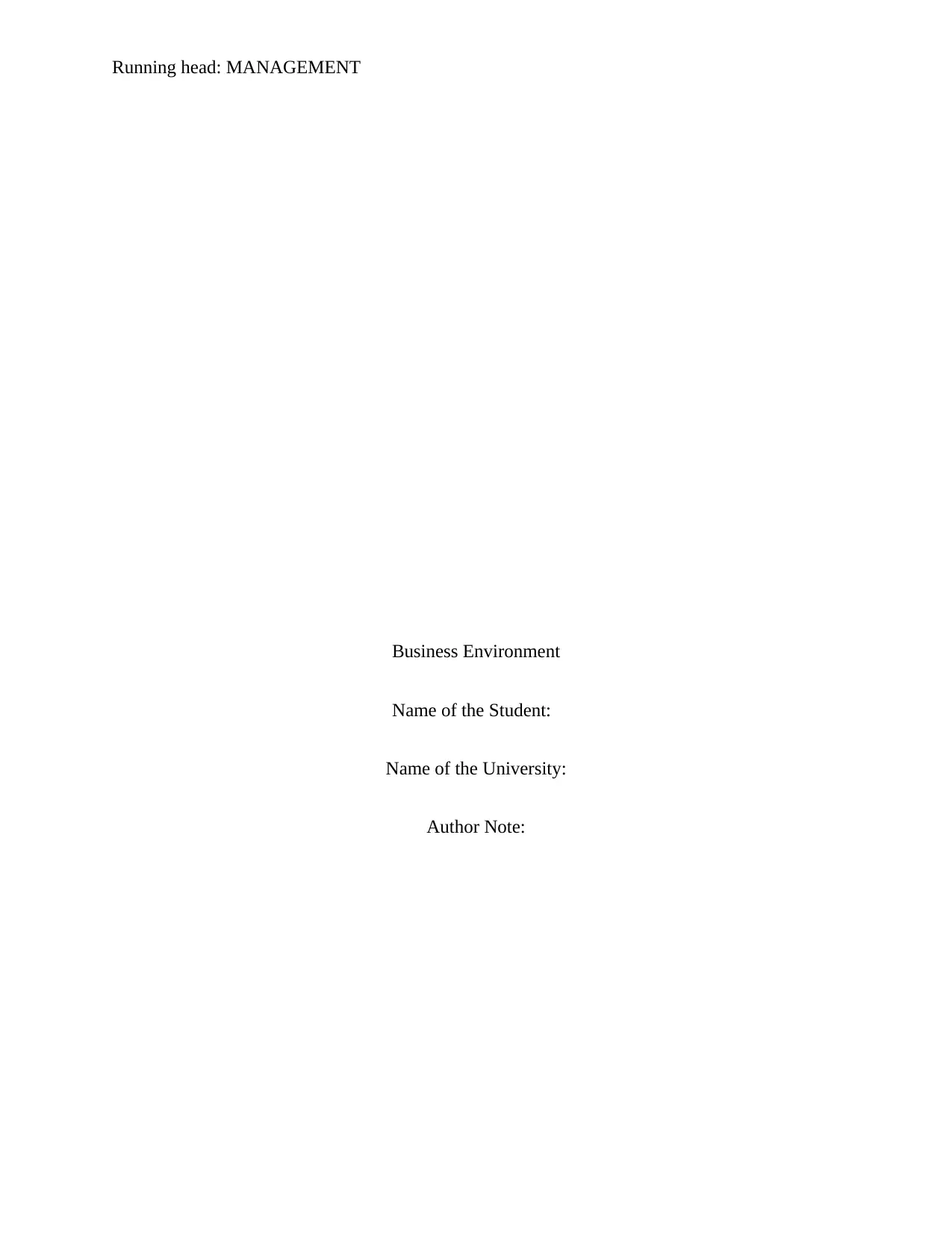
Running head: MANAGEMENT
Business Environment
Name of the Student:
Name of the University:
Author Note:
Business Environment
Name of the Student:
Name of the University:
Author Note:
Paraphrase This Document
Need a fresh take? Get an instant paraphrase of this document with our AI Paraphraser
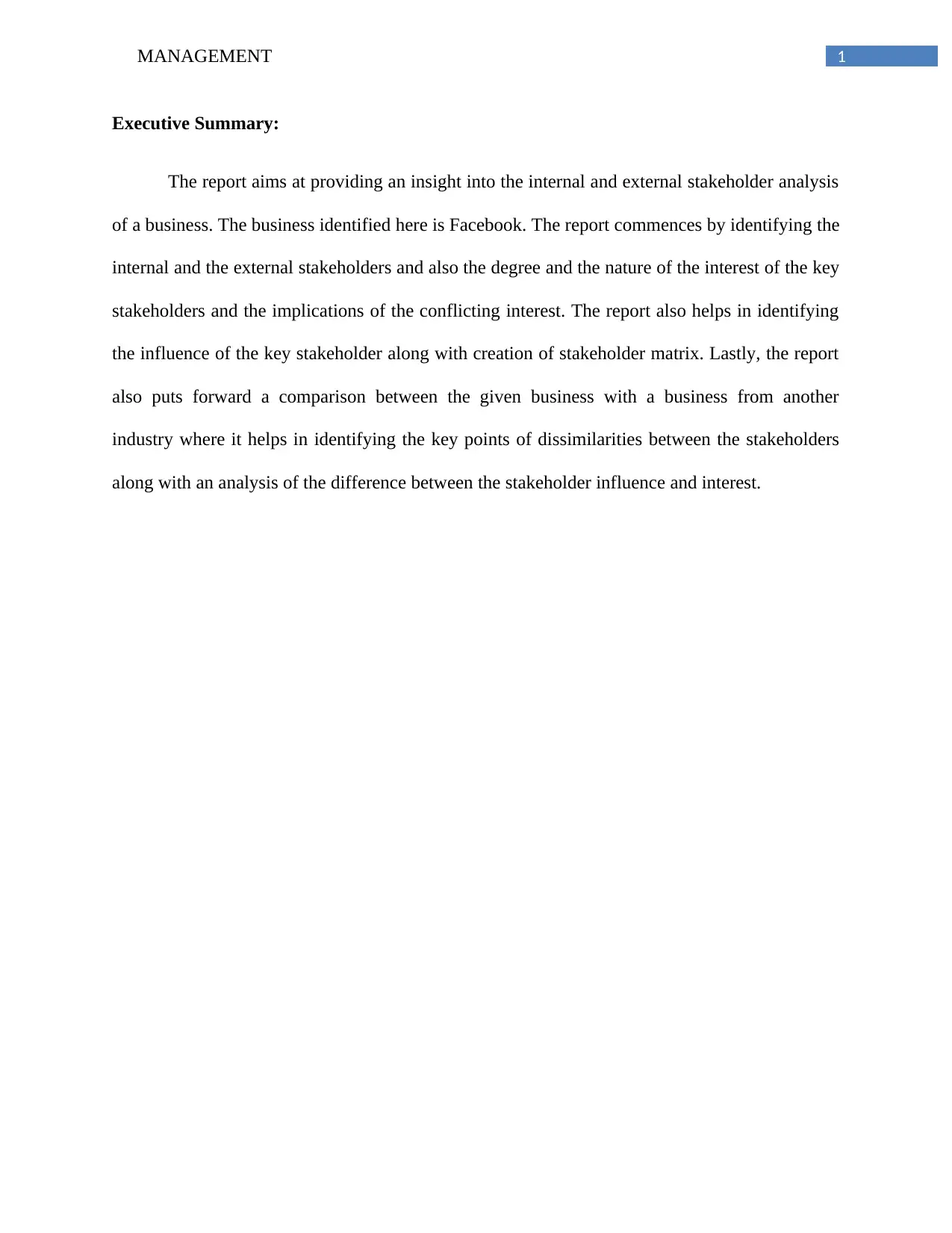
1MANAGEMENT
Executive Summary:
The report aims at providing an insight into the internal and external stakeholder analysis
of a business. The business identified here is Facebook. The report commences by identifying the
internal and the external stakeholders and also the degree and the nature of the interest of the key
stakeholders and the implications of the conflicting interest. The report also helps in identifying
the influence of the key stakeholder along with creation of stakeholder matrix. Lastly, the report
also puts forward a comparison between the given business with a business from another
industry where it helps in identifying the key points of dissimilarities between the stakeholders
along with an analysis of the difference between the stakeholder influence and interest.
Executive Summary:
The report aims at providing an insight into the internal and external stakeholder analysis
of a business. The business identified here is Facebook. The report commences by identifying the
internal and the external stakeholders and also the degree and the nature of the interest of the key
stakeholders and the implications of the conflicting interest. The report also helps in identifying
the influence of the key stakeholder along with creation of stakeholder matrix. Lastly, the report
also puts forward a comparison between the given business with a business from another
industry where it helps in identifying the key points of dissimilarities between the stakeholders
along with an analysis of the difference between the stakeholder influence and interest.
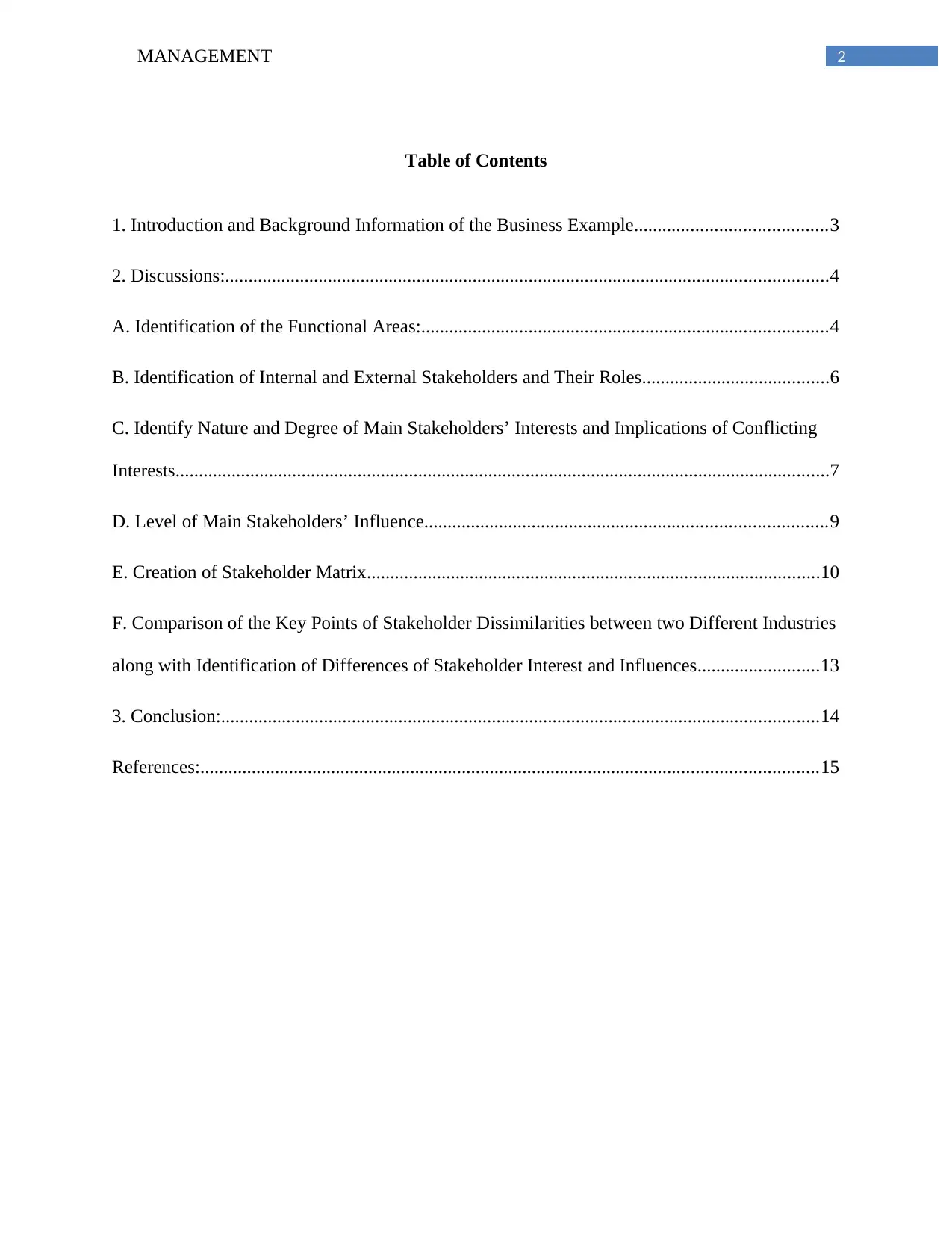
2MANAGEMENT
Table of Contents
1. Introduction and Background Information of the Business Example.........................................3
2. Discussions:.................................................................................................................................4
A. Identification of the Functional Areas:.......................................................................................4
B. Identification of Internal and External Stakeholders and Their Roles........................................6
C. Identify Nature and Degree of Main Stakeholders’ Interests and Implications of Conflicting
Interests............................................................................................................................................7
D. Level of Main Stakeholders’ Influence......................................................................................9
E. Creation of Stakeholder Matrix.................................................................................................10
F. Comparison of the Key Points of Stakeholder Dissimilarities between two Different Industries
along with Identification of Differences of Stakeholder Interest and Influences..........................13
3. Conclusion:................................................................................................................................14
References:....................................................................................................................................15
Table of Contents
1. Introduction and Background Information of the Business Example.........................................3
2. Discussions:.................................................................................................................................4
A. Identification of the Functional Areas:.......................................................................................4
B. Identification of Internal and External Stakeholders and Their Roles........................................6
C. Identify Nature and Degree of Main Stakeholders’ Interests and Implications of Conflicting
Interests............................................................................................................................................7
D. Level of Main Stakeholders’ Influence......................................................................................9
E. Creation of Stakeholder Matrix.................................................................................................10
F. Comparison of the Key Points of Stakeholder Dissimilarities between two Different Industries
along with Identification of Differences of Stakeholder Interest and Influences..........................13
3. Conclusion:................................................................................................................................14
References:....................................................................................................................................15
⊘ This is a preview!⊘
Do you want full access?
Subscribe today to unlock all pages.

Trusted by 1+ million students worldwide
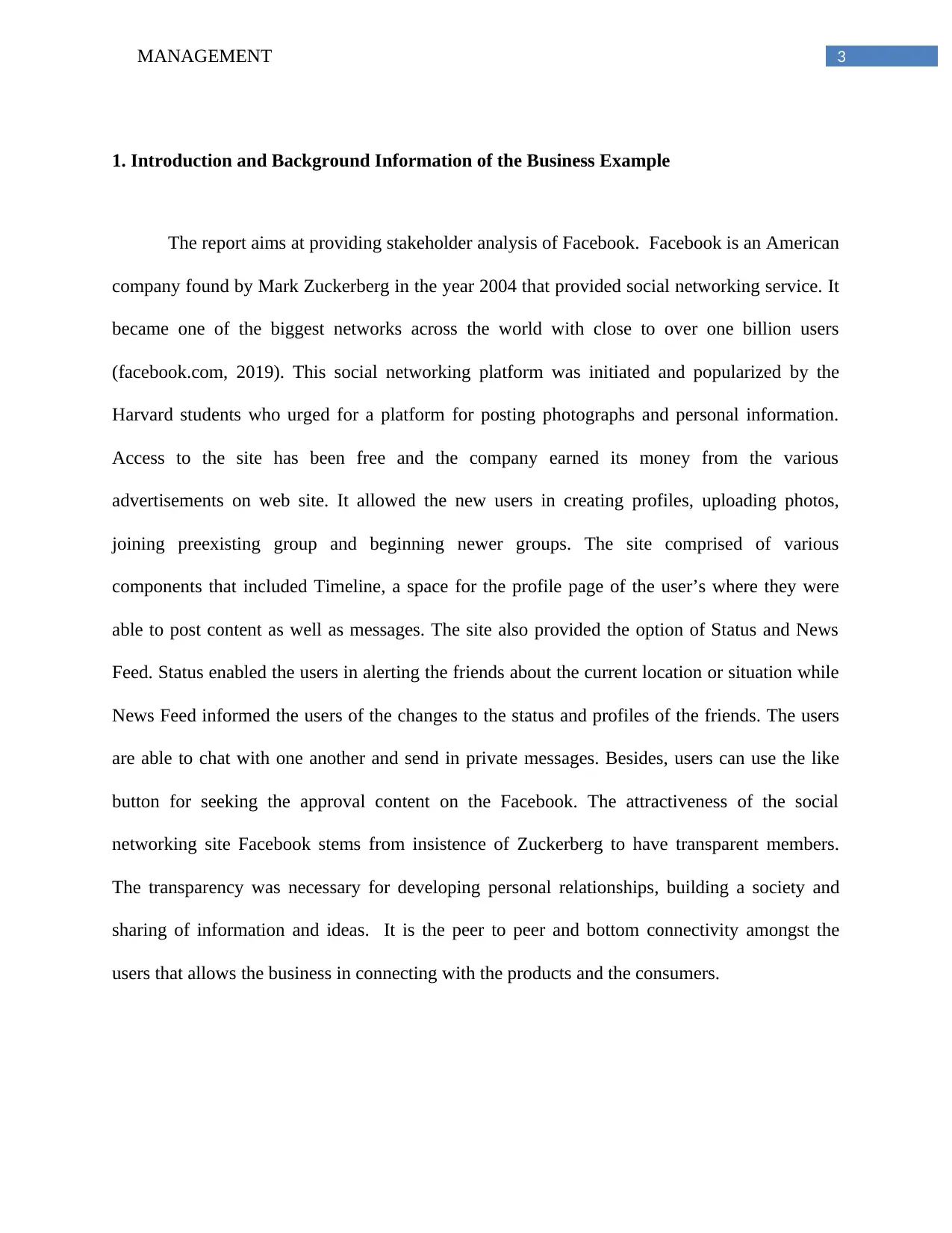
3MANAGEMENT
1. Introduction and Background Information of the Business Example
The report aims at providing stakeholder analysis of Facebook. Facebook is an American
company found by Mark Zuckerberg in the year 2004 that provided social networking service. It
became one of the biggest networks across the world with close to over one billion users
(facebook.com, 2019). This social networking platform was initiated and popularized by the
Harvard students who urged for a platform for posting photographs and personal information.
Access to the site has been free and the company earned its money from the various
advertisements on web site. It allowed the new users in creating profiles, uploading photos,
joining preexisting group and beginning newer groups. The site comprised of various
components that included Timeline, a space for the profile page of the user’s where they were
able to post content as well as messages. The site also provided the option of Status and News
Feed. Status enabled the users in alerting the friends about the current location or situation while
News Feed informed the users of the changes to the status and profiles of the friends. The users
are able to chat with one another and send in private messages. Besides, users can use the like
button for seeking the approval content on the Facebook. The attractiveness of the social
networking site Facebook stems from insistence of Zuckerberg to have transparent members.
The transparency was necessary for developing personal relationships, building a society and
sharing of information and ideas. It is the peer to peer and bottom connectivity amongst the
users that allows the business in connecting with the products and the consumers.
1. Introduction and Background Information of the Business Example
The report aims at providing stakeholder analysis of Facebook. Facebook is an American
company found by Mark Zuckerberg in the year 2004 that provided social networking service. It
became one of the biggest networks across the world with close to over one billion users
(facebook.com, 2019). This social networking platform was initiated and popularized by the
Harvard students who urged for a platform for posting photographs and personal information.
Access to the site has been free and the company earned its money from the various
advertisements on web site. It allowed the new users in creating profiles, uploading photos,
joining preexisting group and beginning newer groups. The site comprised of various
components that included Timeline, a space for the profile page of the user’s where they were
able to post content as well as messages. The site also provided the option of Status and News
Feed. Status enabled the users in alerting the friends about the current location or situation while
News Feed informed the users of the changes to the status and profiles of the friends. The users
are able to chat with one another and send in private messages. Besides, users can use the like
button for seeking the approval content on the Facebook. The attractiveness of the social
networking site Facebook stems from insistence of Zuckerberg to have transparent members.
The transparency was necessary for developing personal relationships, building a society and
sharing of information and ideas. It is the peer to peer and bottom connectivity amongst the
users that allows the business in connecting with the products and the consumers.
Paraphrase This Document
Need a fresh take? Get an instant paraphrase of this document with our AI Paraphraser
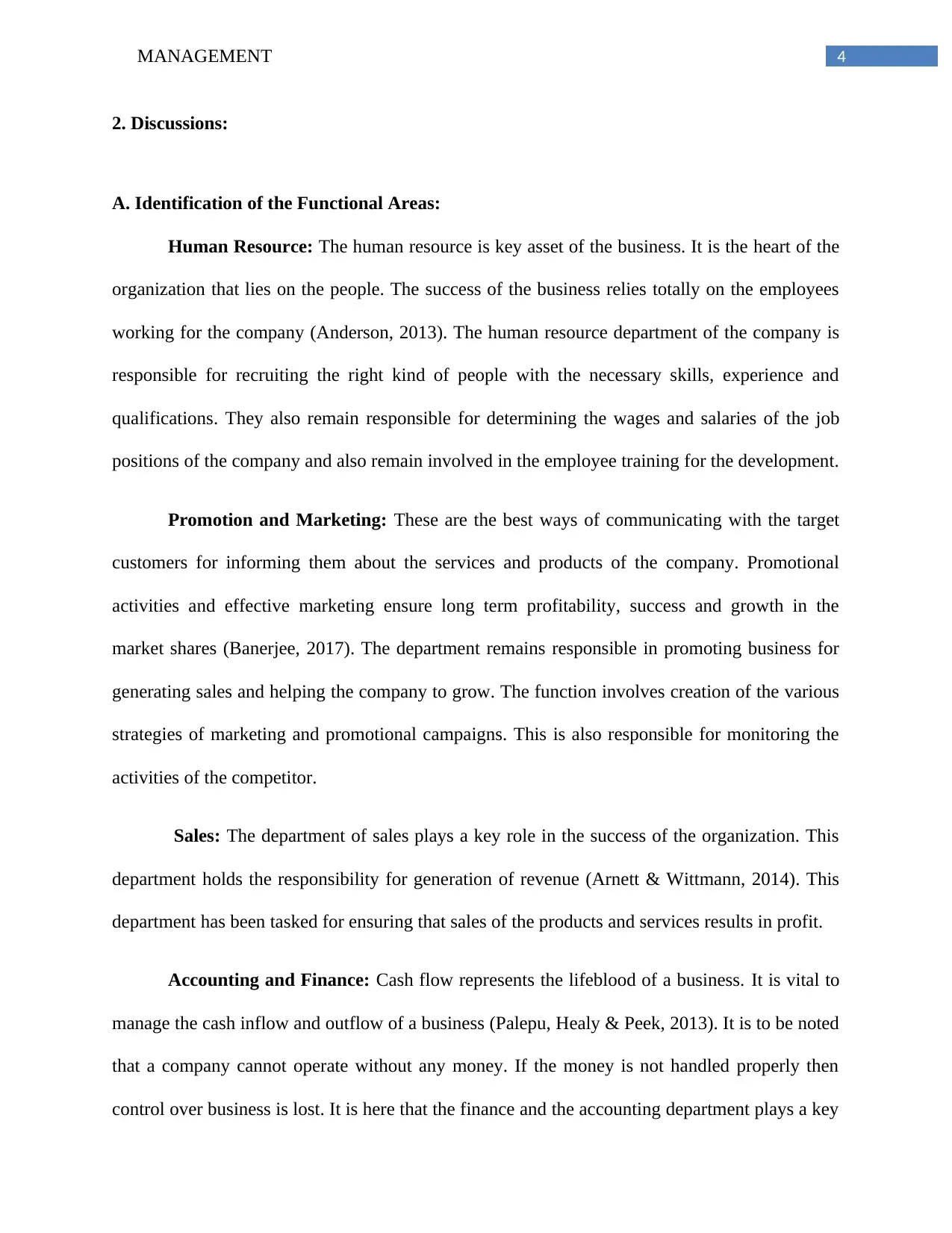
4MANAGEMENT
2. Discussions:
A. Identification of the Functional Areas:
Human Resource: The human resource is key asset of the business. It is the heart of the
organization that lies on the people. The success of the business relies totally on the employees
working for the company (Anderson, 2013). The human resource department of the company is
responsible for recruiting the right kind of people with the necessary skills, experience and
qualifications. They also remain responsible for determining the wages and salaries of the job
positions of the company and also remain involved in the employee training for the development.
Promotion and Marketing: These are the best ways of communicating with the target
customers for informing them about the services and products of the company. Promotional
activities and effective marketing ensure long term profitability, success and growth in the
market shares (Banerjee, 2017). The department remains responsible in promoting business for
generating sales and helping the company to grow. The function involves creation of the various
strategies of marketing and promotional campaigns. This is also responsible for monitoring the
activities of the competitor.
Sales: The department of sales plays a key role in the success of the organization. This
department holds the responsibility for generation of revenue (Arnett & Wittmann, 2014). This
department has been tasked for ensuring that sales of the products and services results in profit.
Accounting and Finance: Cash flow represents the lifeblood of a business. It is vital to
manage the cash inflow and outflow of a business (Palepu, Healy & Peek, 2013). It is to be noted
that a company cannot operate without any money. If the money is not handled properly then
control over business is lost. It is here that the finance and the accounting department plays a key
2. Discussions:
A. Identification of the Functional Areas:
Human Resource: The human resource is key asset of the business. It is the heart of the
organization that lies on the people. The success of the business relies totally on the employees
working for the company (Anderson, 2013). The human resource department of the company is
responsible for recruiting the right kind of people with the necessary skills, experience and
qualifications. They also remain responsible for determining the wages and salaries of the job
positions of the company and also remain involved in the employee training for the development.
Promotion and Marketing: These are the best ways of communicating with the target
customers for informing them about the services and products of the company. Promotional
activities and effective marketing ensure long term profitability, success and growth in the
market shares (Banerjee, 2017). The department remains responsible in promoting business for
generating sales and helping the company to grow. The function involves creation of the various
strategies of marketing and promotional campaigns. This is also responsible for monitoring the
activities of the competitor.
Sales: The department of sales plays a key role in the success of the organization. This
department holds the responsibility for generation of revenue (Arnett & Wittmann, 2014). This
department has been tasked for ensuring that sales of the products and services results in profit.
Accounting and Finance: Cash flow represents the lifeblood of a business. It is vital to
manage the cash inflow and outflow of a business (Palepu, Healy & Peek, 2013). It is to be noted
that a company cannot operate without any money. If the money is not handled properly then
control over business is lost. It is here that the finance and the accounting department plays a key
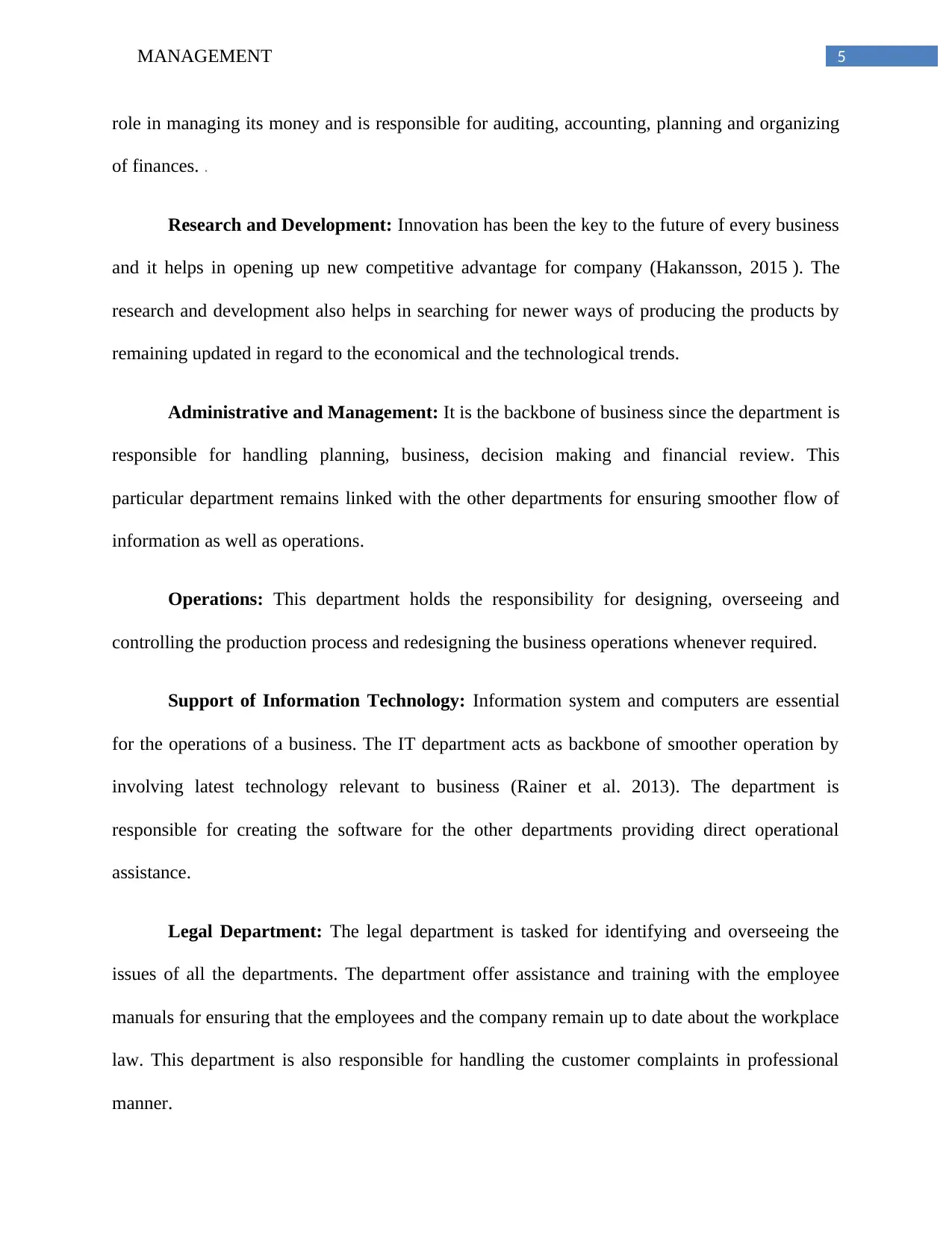
5MANAGEMENT
role in managing its money and is responsible for auditing, accounting, planning and organizing
of finances. .
Research and Development: Innovation has been the key to the future of every business
and it helps in opening up new competitive advantage for company (Hakansson, 2015 ). The
research and development also helps in searching for newer ways of producing the products by
remaining updated in regard to the economical and the technological trends.
Administrative and Management: It is the backbone of business since the department is
responsible for handling planning, business, decision making and financial review. This
particular department remains linked with the other departments for ensuring smoother flow of
information as well as operations.
Operations: This department holds the responsibility for designing, overseeing and
controlling the production process and redesigning the business operations whenever required.
Support of Information Technology: Information system and computers are essential
for the operations of a business. The IT department acts as backbone of smoother operation by
involving latest technology relevant to business (Rainer et al. 2013). The department is
responsible for creating the software for the other departments providing direct operational
assistance.
Legal Department: The legal department is tasked for identifying and overseeing the
issues of all the departments. The department offer assistance and training with the employee
manuals for ensuring that the employees and the company remain up to date about the workplace
law. This department is also responsible for handling the customer complaints in professional
manner.
role in managing its money and is responsible for auditing, accounting, planning and organizing
of finances. .
Research and Development: Innovation has been the key to the future of every business
and it helps in opening up new competitive advantage for company (Hakansson, 2015 ). The
research and development also helps in searching for newer ways of producing the products by
remaining updated in regard to the economical and the technological trends.
Administrative and Management: It is the backbone of business since the department is
responsible for handling planning, business, decision making and financial review. This
particular department remains linked with the other departments for ensuring smoother flow of
information as well as operations.
Operations: This department holds the responsibility for designing, overseeing and
controlling the production process and redesigning the business operations whenever required.
Support of Information Technology: Information system and computers are essential
for the operations of a business. The IT department acts as backbone of smoother operation by
involving latest technology relevant to business (Rainer et al. 2013). The department is
responsible for creating the software for the other departments providing direct operational
assistance.
Legal Department: The legal department is tasked for identifying and overseeing the
issues of all the departments. The department offer assistance and training with the employee
manuals for ensuring that the employees and the company remain up to date about the workplace
law. This department is also responsible for handling the customer complaints in professional
manner.
⊘ This is a preview!⊘
Do you want full access?
Subscribe today to unlock all pages.

Trusted by 1+ million students worldwide
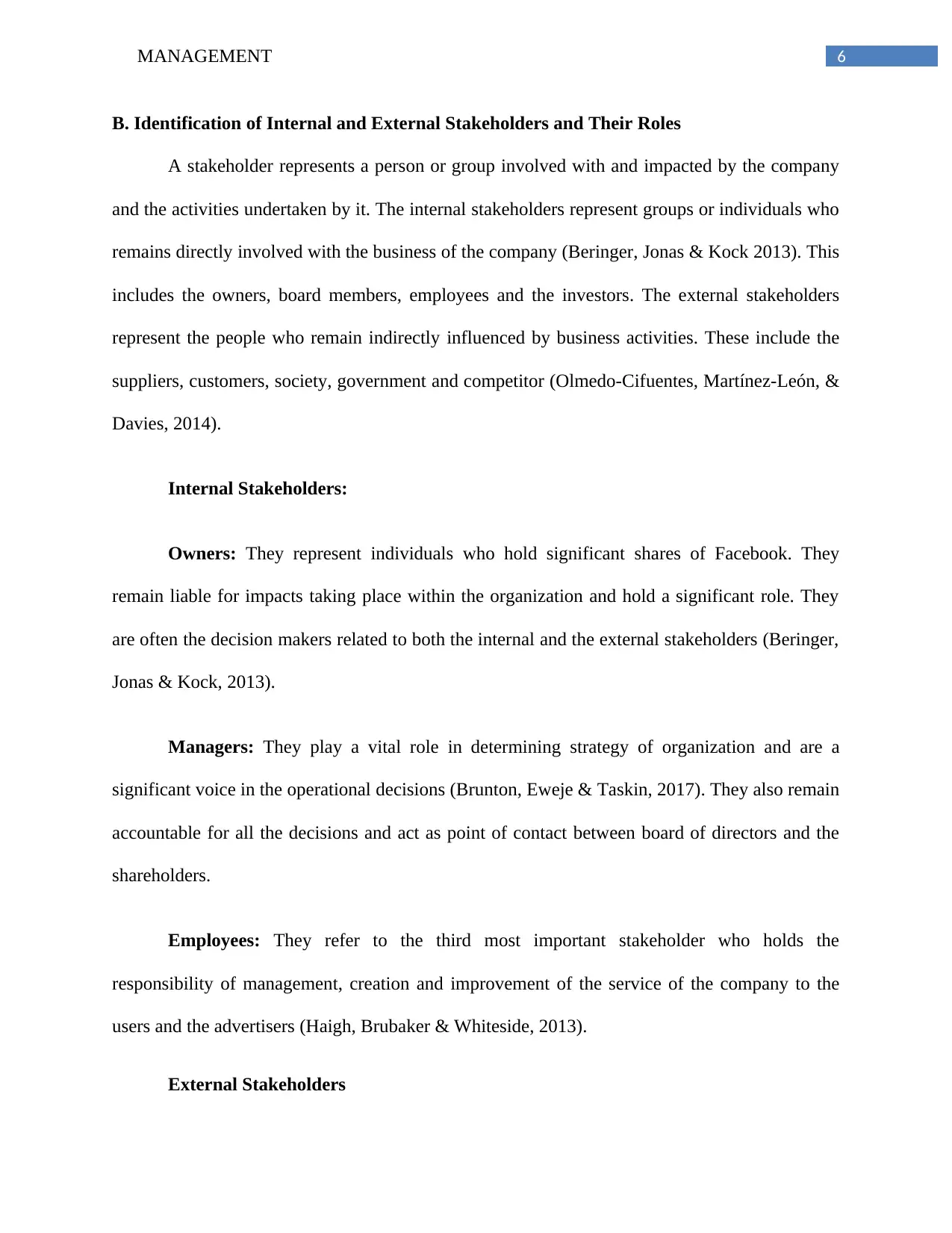
6MANAGEMENT
B. Identification of Internal and External Stakeholders and Their Roles
A stakeholder represents a person or group involved with and impacted by the company
and the activities undertaken by it. The internal stakeholders represent groups or individuals who
remains directly involved with the business of the company (Beringer, Jonas & Kock 2013). This
includes the owners, board members, employees and the investors. The external stakeholders
represent the people who remain indirectly influenced by business activities. These include the
suppliers, customers, society, government and competitor (Olmedo-Cifuentes, Martínez-León, &
Davies, 2014).
Internal Stakeholders:
Owners: They represent individuals who hold significant shares of Facebook. They
remain liable for impacts taking place within the organization and hold a significant role. They
are often the decision makers related to both the internal and the external stakeholders (Beringer,
Jonas & Kock, 2013).
Managers: They play a vital role in determining strategy of organization and are a
significant voice in the operational decisions (Brunton, Eweje & Taskin, 2017). They also remain
accountable for all the decisions and act as point of contact between board of directors and the
shareholders.
Employees: They refer to the third most important stakeholder who holds the
responsibility of management, creation and improvement of the service of the company to the
users and the advertisers (Haigh, Brubaker & Whiteside, 2013).
External Stakeholders
B. Identification of Internal and External Stakeholders and Their Roles
A stakeholder represents a person or group involved with and impacted by the company
and the activities undertaken by it. The internal stakeholders represent groups or individuals who
remains directly involved with the business of the company (Beringer, Jonas & Kock 2013). This
includes the owners, board members, employees and the investors. The external stakeholders
represent the people who remain indirectly influenced by business activities. These include the
suppliers, customers, society, government and competitor (Olmedo-Cifuentes, Martínez-León, &
Davies, 2014).
Internal Stakeholders:
Owners: They represent individuals who hold significant shares of Facebook. They
remain liable for impacts taking place within the organization and hold a significant role. They
are often the decision makers related to both the internal and the external stakeholders (Beringer,
Jonas & Kock, 2013).
Managers: They play a vital role in determining strategy of organization and are a
significant voice in the operational decisions (Brunton, Eweje & Taskin, 2017). They also remain
accountable for all the decisions and act as point of contact between board of directors and the
shareholders.
Employees: They refer to the third most important stakeholder who holds the
responsibility of management, creation and improvement of the service of the company to the
users and the advertisers (Haigh, Brubaker & Whiteside, 2013).
External Stakeholders
Paraphrase This Document
Need a fresh take? Get an instant paraphrase of this document with our AI Paraphraser
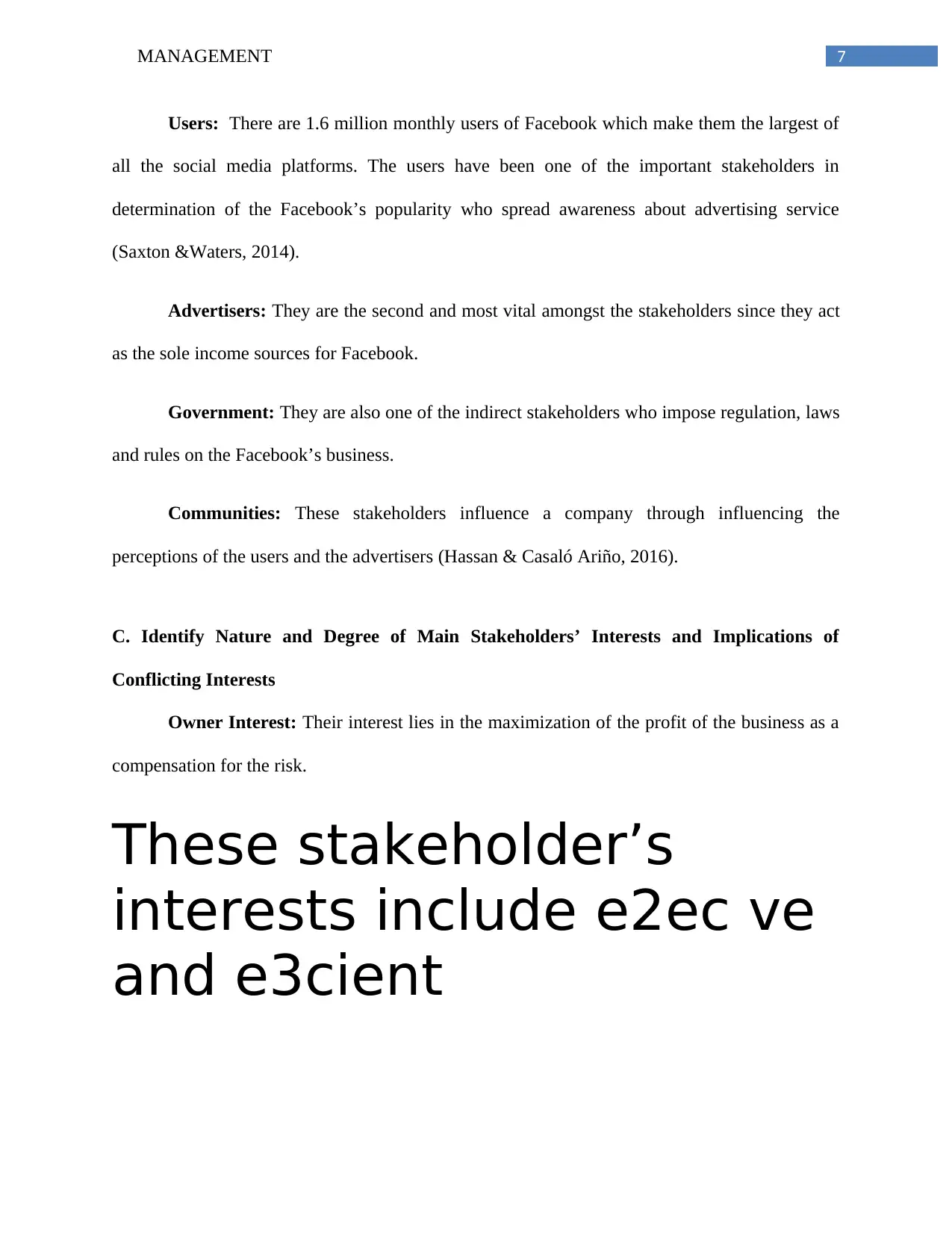
7MANAGEMENT
Users: There are 1.6 million monthly users of Facebook which make them the largest of
all the social media platforms. The users have been one of the important stakeholders in
determination of the Facebook’s popularity who spread awareness about advertising service
(Saxton &Waters, 2014).
Advertisers: They are the second and most vital amongst the stakeholders since they act
as the sole income sources for Facebook.
Government: They are also one of the indirect stakeholders who impose regulation, laws
and rules on the Facebook’s business.
Communities: These stakeholders influence a company through influencing the
perceptions of the users and the advertisers (Hassan & Casaló Ariño, 2016).
C. Identify Nature and Degree of Main Stakeholders’ Interests and Implications of
Conflicting Interests
Owner Interest: Their interest lies in the maximization of the profit of the business as a
compensation for the risk.
These stakeholder’s
interests include e2ec ve
and e3cient
Users: There are 1.6 million monthly users of Facebook which make them the largest of
all the social media platforms. The users have been one of the important stakeholders in
determination of the Facebook’s popularity who spread awareness about advertising service
(Saxton &Waters, 2014).
Advertisers: They are the second and most vital amongst the stakeholders since they act
as the sole income sources for Facebook.
Government: They are also one of the indirect stakeholders who impose regulation, laws
and rules on the Facebook’s business.
Communities: These stakeholders influence a company through influencing the
perceptions of the users and the advertisers (Hassan & Casaló Ariño, 2016).
C. Identify Nature and Degree of Main Stakeholders’ Interests and Implications of
Conflicting Interests
Owner Interest: Their interest lies in the maximization of the profit of the business as a
compensation for the risk.
These stakeholder’s
interests include e2ec ve
and e3cient
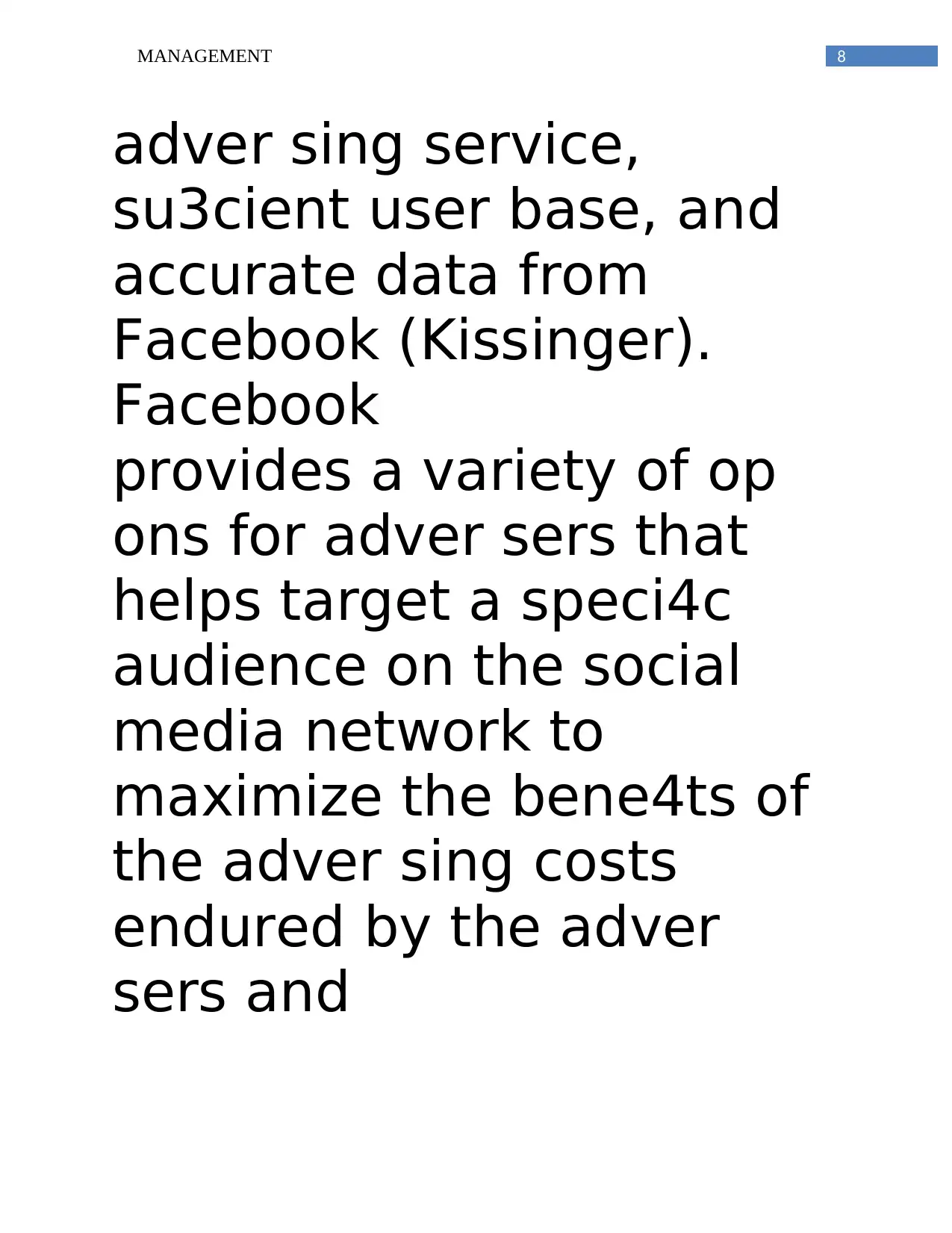
8MANAGEMENT
adver sing service,
su3cient user base, and
accurate data from
Facebook (Kissinger).
Facebook
provides a variety of op
ons for adver sers that
helps target a speci4c
audience on the social
media network to
maximize the bene4ts of
the adver sing costs
endured by the adver
sers and
adver sing service,
su3cient user base, and
accurate data from
Facebook (Kissinger).
provides a variety of op
ons for adver sers that
helps target a speci4c
audience on the social
media network to
maximize the bene4ts of
the adver sing costs
endured by the adver
sers and
⊘ This is a preview!⊘
Do you want full access?
Subscribe today to unlock all pages.

Trusted by 1+ million students worldwide
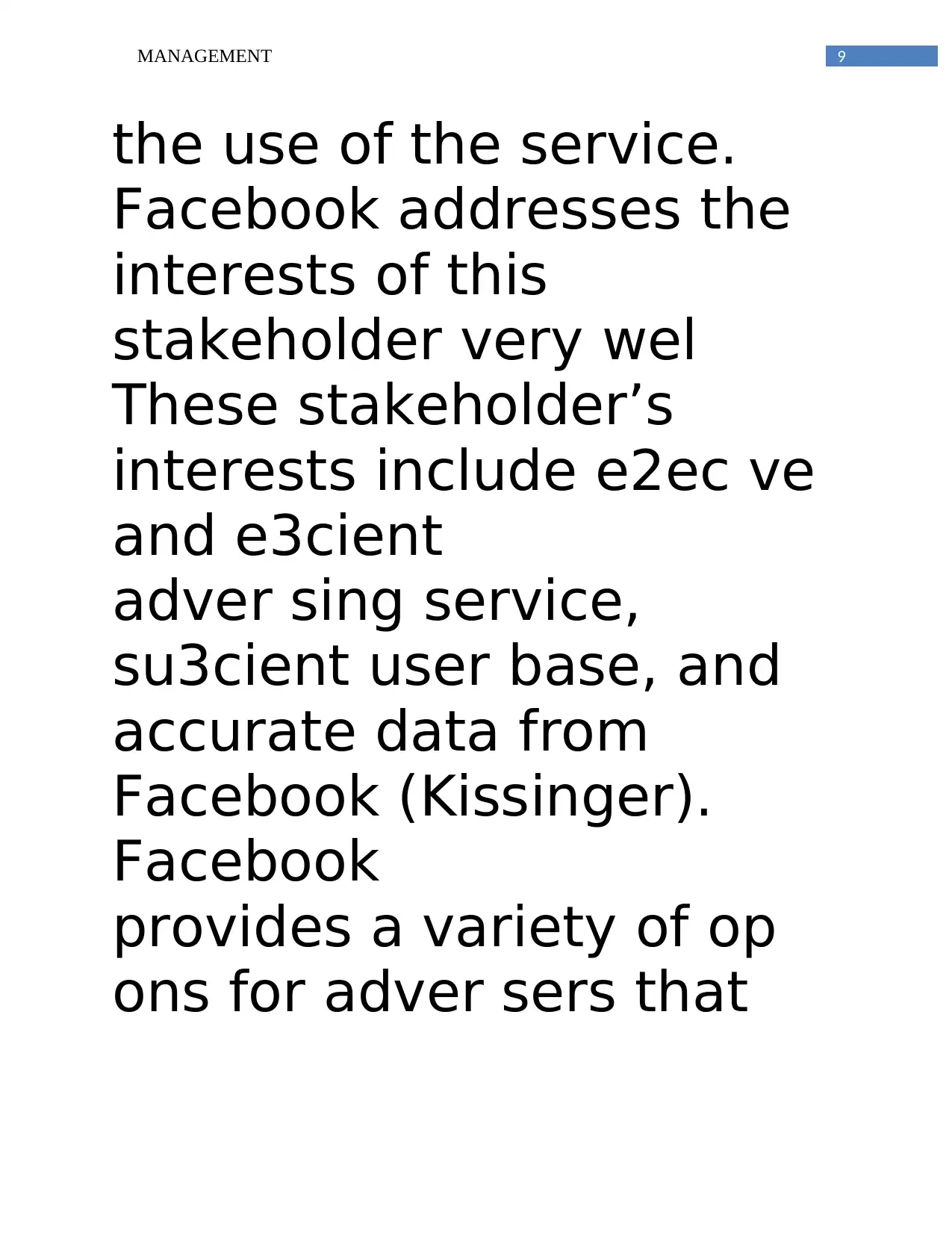
9MANAGEMENT
the use of the service.
Facebook addresses the
interests of this
stakeholder very wel
These stakeholder’s
interests include e2ec ve
and e3cient
adver sing service,
su3cient user base, and
accurate data from
Facebook (Kissinger).
Facebook
provides a variety of op
ons for adver sers that
the use of the service.
Facebook addresses the
interests of this
stakeholder very wel
These stakeholder’s
interests include e2ec ve
and e3cient
adver sing service,
su3cient user base, and
accurate data from
Facebook (Kissinger).
provides a variety of op
ons for adver sers that
Paraphrase This Document
Need a fresh take? Get an instant paraphrase of this document with our AI Paraphraser
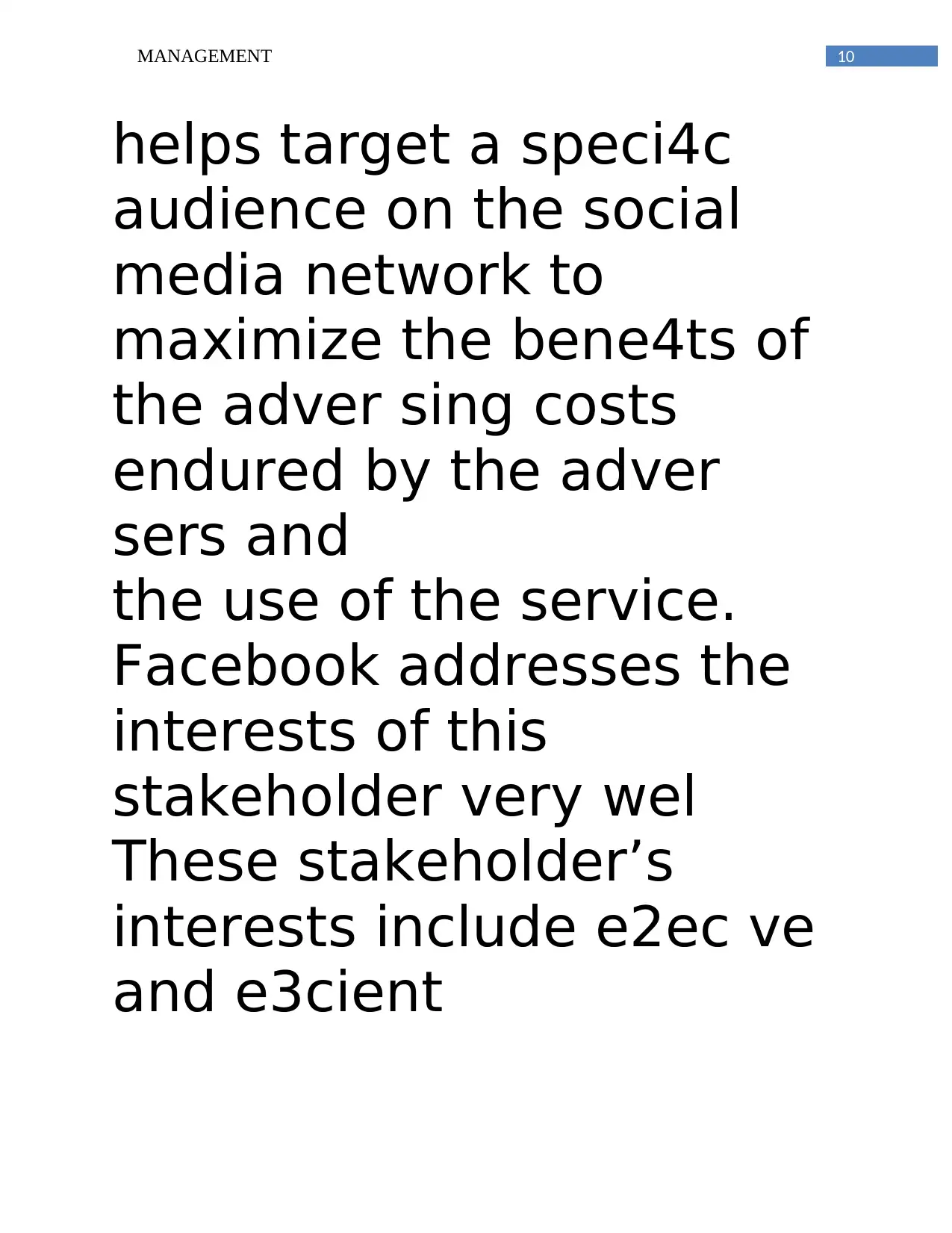
10MANAGEMENT
helps target a speci4c
audience on the social
media network to
maximize the bene4ts of
the adver sing costs
endured by the adver
sers and
the use of the service.
Facebook addresses the
interests of this
stakeholder very wel
These stakeholder’s
interests include e2ec ve
and e3cient
helps target a speci4c
audience on the social
media network to
maximize the bene4ts of
the adver sing costs
endured by the adver
sers and
the use of the service.
Facebook addresses the
interests of this
stakeholder very wel
These stakeholder’s
interests include e2ec ve
and e3cient
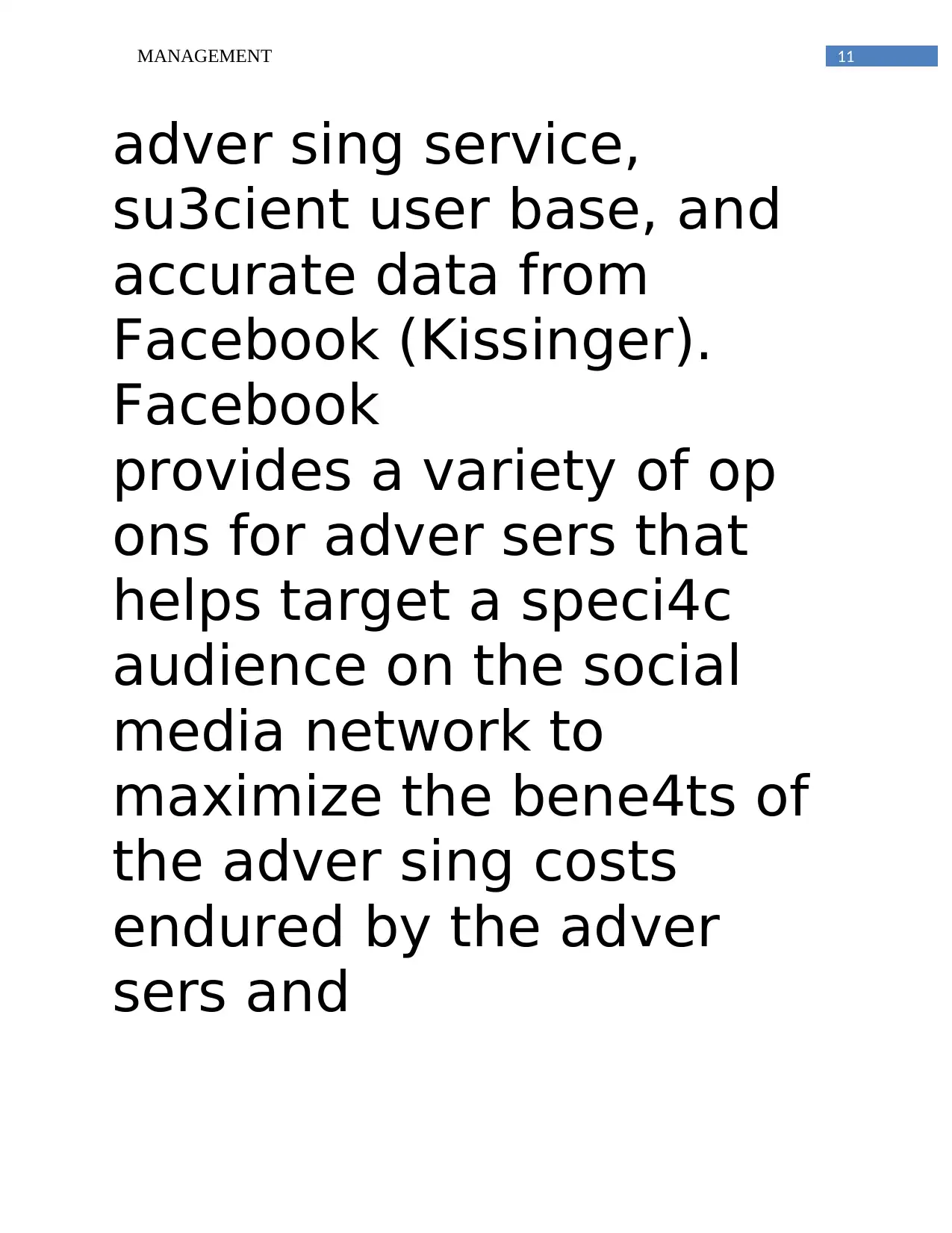
11MANAGEMENT
adver sing service,
su3cient user base, and
accurate data from
Facebook (Kissinger).
Facebook
provides a variety of op
ons for adver sers that
helps target a speci4c
audience on the social
media network to
maximize the bene4ts of
the adver sing costs
endured by the adver
sers and
adver sing service,
su3cient user base, and
accurate data from
Facebook (Kissinger).
provides a variety of op
ons for adver sers that
helps target a speci4c
audience on the social
media network to
maximize the bene4ts of
the adver sing costs
endured by the adver
sers and
⊘ This is a preview!⊘
Do you want full access?
Subscribe today to unlock all pages.

Trusted by 1+ million students worldwide
1 out of 25
Related Documents
Your All-in-One AI-Powered Toolkit for Academic Success.
+13062052269
info@desklib.com
Available 24*7 on WhatsApp / Email
![[object Object]](/_next/static/media/star-bottom.7253800d.svg)
Unlock your academic potential
Copyright © 2020–2025 A2Z Services. All Rights Reserved. Developed and managed by ZUCOL.





